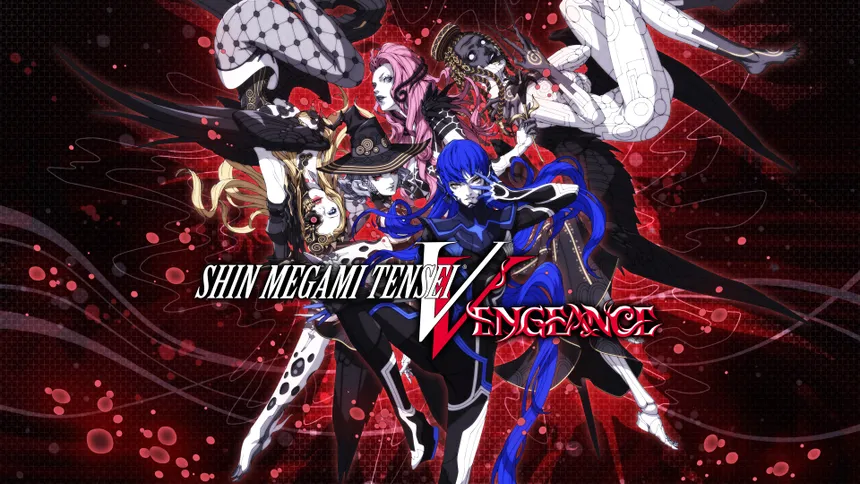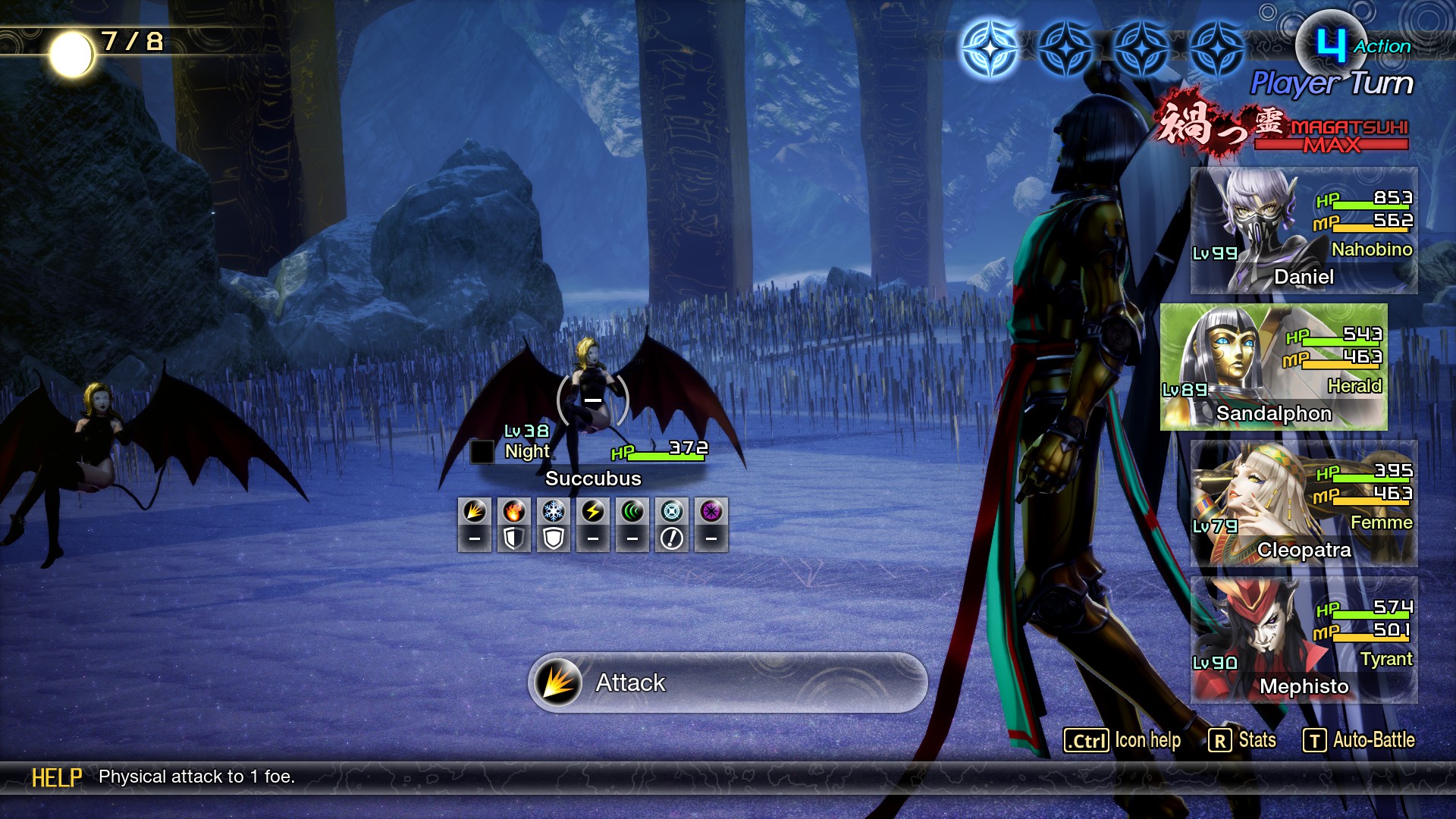Search
[{{{type}}}] {{{reason}}}
{{/data.error.root_cause}}{{{_source.title}}} {{#_source.showPrice}} {{{_source.displayPrice}}} {{/_source.showPrice}}
{{#_source.showLink}} {{/_source.showLink}} {{#_source.showDate}}{{{_source.displayDate}}}
{{/_source.showDate}}{{{_source.description}}}
{{#_source.additionalInfo}}{{#_source.additionalFields}} {{#title}} {{{label}}}: {{{title}}} {{/title}} {{/_source.additionalFields}}
{{/_source.additionalInfo}}- Details
- Category: Computer
- By Daniel Cullen
- Hits: 2674
Shin Megami Tensei V: Vengeance (PC)

Shin Megami Tensei V: Vengeance
Developed By: Atlus
Published By: Sega
Released: June 13, 2024
Available On: Microsoft Windows, PlayStation 4, PlayStation 5, Switch, Xbox One, Xbox Series X/S
Genre: Turn-Based RPG
ESRB Rating: Mature (Violence, Blood, Sexual Themes, Partial Nudity, Strong Language)
Number of Players: Singleplayer
Price: $59.99
(Humble Store Link)
Note: This review will cover the game itself and all relevant paid and free DLC, based on the PC version. Notes regarding the Switch and other versions will be appended where noted. The reader may also wish to review our review of the original Shin Megami Tensei V for Switch for comparison purposes.
Sometimes, game developers release a game in less than optimal circumstances. They didn't like the result, but they had no choice at the time. However, they vow to re-release it later, in a form much closer to their intended vision. Shin Megami Tensei V: Vengeance is this concept incarnate.
A bit of background. The original game was released on the Nintendo Switch, and it was hampered by three big factors. First, it was the first time the developers had made a full HD from the ground-up SMT game. Second, it was the first time the developers had made a game in Unreal Engine 4. Third, COVID strung out the dev team and thus made it hard to coordinate all aspects of development smoothly. The result was a clunky title that had framerate drops, an anemic plot and demon list compared to prior games, and a lot of rough edges that made it feel like a glorified Early Access project rather than a fully realized game. This re-release not only adds all the quality of life enhancement that the original needed, but it also features a lot more content, including concepts intended for the original release.
As for the series itself, Shin Megami Tensei is a Japanese turn-based RPG that mixes all of religion, myth, and urban legend into a blender and explores the themes of the virtues of Law and Chaos. It was the predecessor of Pokemon in the "recruit monsters to fight for you" genre, and via this premise, you control and summon demons (in the original Greek sense of the term, meaning any supernatural being) to help you in your battles while you fight alongside them.
Shin Megami Tensei V starts with your protagonist, a male student of a Tokyo high school, finding himself transported to an alternate world called 'Da'at". While there, he discovers the world he thought he knew is dying, no longer under the protection of the God of Law. He learns he has the power to change this and becomes part of a conflict where various others who have their own ideas of what Law should govern creation will vie for the throne of God's authority.
This re-release, Vengeance, adds a new story that can be chosen at the start (with the original and new story called the Canon of Creation and Vengeance respectively) that makes the tale unfold differently, with new friends and foes. It also fleshes out a lot of the unfinished aspects of the original release, adds more demons and other content, and serves as the version of the game closer to the intentions of the developers.
Like all turn-based RPGs, this one is based primarily around exploring various world areas and dungeons, fighting demons, advancing the story, and choosing a side towards the end to achieve the ending of the player's choice. Both routes have their own take on the general plot and use the same settings of Tokyo and Da'at, but the plot will unfold in different ways, with some content exclusive to each "Canon" with a New Game Plus style feature so the player can eventually enjoy all content.
A lot of quality-of-life features have been added. The balance has been reworked for a smoother leveling curve, and battles now have a lot more strategic options. The world map now feels far less empty with far more activities and sidequests. The original story route is still as thin as before, but it now benefits from the enhanced engine and reworked mechanics as well. More content has been added to the base game in both routes and beating each story route in certain ways unlocks bonus content in the other, so both are worth playing.
Graphically, this is an Unreal Engine 4 game set in a fully 3-D world. It features a cel-shaded animation style that goes well with Tokyo's modern look and Da'at's varied and alien-looking landscapes and settings. Being the first in the series to be fully 3-D AND designed to be in HD level quality from the start (the third game was only made HD in re-releases), the models look high quality. Animation is smooth, though non-important characters are rendered with blank, doll-like faces.

Strong Points: There is much more optimization and polish over the original with many quality-of-life enhancements; the new story is well done
Weak Points: The original plot still feels a bit thin
Moral Warnings: Androgynous lead character; language (*ss, d*mn, sh*t, f*ck); you have to forge alliances with demons in order to succeed; many deities and demons from various religions are represented here; some of the female demons have an aversion to clothes; some demons like Mara are clearly designed after the male reproductive organ; combat violence and bloodshed
The music and sounds are a mix of contrasts. While featuring a few rock remixes of some classic music from other SMT games, the soundtrack leans heavily on synth, electronica, some dubstep, and even a lot of ambient tracks. Given most of the latter play in the bizarre post-apocalyptic landscapes of Da'at, it really helps set the mood for how alien it feels compared to modern-day Tokyo. The game is voice-acted in English and Japanese, and both dubs are quite competent.
This game can be controlled with the keyboard and mouse, or with a Steam-supported PC gamepad. I recommend the latter option (either Xbox or PlayStation-style controllers will work well), but the former is entirely viable if somewhat clunky for movement. Keys can be remapped, but I found the default setup works fine, especially on controllers.
Stability-wise, this is very well optimized, especially compared to the original game. The developers clearly are much more adept with Unreal Engine 4 this time and it ran smoothly at the highest settings on my laptop. Switch users should also see smoother gameplay due to engine optimizations. There is a feature for Switch owners of the original game to transfer some limited save data to the updated version of this game. This game runs natively on Microsoft Windows and will run on the Steam Deck as Verified and on Linux via Steam Proton out of the box.
Some final technical notes on the DLC, both free and paid:
Safety (Free): A "Very Easy" DLC that makes the game effortless, recommended only for those wishing to see the story minus the gameplay.
Mitama DLCs (Paid): These DLCs allow the player to easily level up, gain lots of money, and otherwise make the game much easier. It is recommended to have these off for a first playthrough for an actual challenge.
Demon Sub Quest (Paid): These DLCs add new demons available only via these DLCs for player use.
Morally, this is a title aimed at mature audiences and thus is going to have a lot of mature subject matter.
Violence most of the time is RPG give orders and watch it happen style, with bodies that disappear after death, usually in a red haze of "magatsuhi" particles (and cutaway camera angles to avoid graphic death scenes despite the sterile depiction of the fading magatsuhi cloud). However, especially on the new Vengeance route, there are some scenes of intense bloody violence. One rather gruesome scene portrays a demon over a barely alive human with a seeping blood pool, with the implication that said person had their eyes gouged out. We are spared actually seeing their face, but the implications are grisly enough.
Language is going to get earthy. Expect to see every profane word in the dictionary, given the setting is one where you meet demons ranging from the well-spoken to the potty-mouthed and a considerable amount aren't fond of God or any deity. A few crude remarks are also uttered referencing crude humor and bodily functions as well.

Higher is better
(10/10 is perfect)
Game Score - 94%
Gameplay: 19/20
Graphics: 9/10
Sound: 9/10
Stability: 5/5
Controls: 5/5
Morality Score - 26%
Violence - 1/10
Language - 5/10
Sexual Content - 1/10
Occult/Supernatural - 0/10
Cultural/Moral/Ethical - 6/10
In the sexuality department, some demons are practically naked save for the usual absence of genitalia. However, there is the infamous Mara, a recurring demon that looks like a giant male member, and one female demon with barely anything on with a jiggling bust on the new game route especially. There are also a few sexual jokes and references, as a few demons will flirt with the player or such is implied to be done in the demon negotiation scenes.
The occult and supernatural have a profound presence, given the Shin Megami Tensei's series penchant for throwing all religions and myths in a blender. The player must summon and use demons (in the Greek sense of the term, angelic beings are included here as well), and while the magic system is largely fictional, real-world religions (modern and defunct) of all types are extensively referenced.
The game plot is essentially that God's Will no longer exists in the universe of SMTV (as it is part of a multiverse). As a Nabohino, you have the ability to restore God's Will so that His Law will once again reign over the universe (Law ending), destroy any chances of it happening (Neutral ending), make a world where all deities can be worshiped as one pleases (Chaos ending), or create a world where all divine/supernatural influence is forever excluded ("True" Neutral ending). The new Vengeance route merely changes the "Chaos/Polytheistic" ending to have a new focus should the player choose that Canon. The "Canon of Vengeance" route does, however, eliminate the Neutral options, leaving only a tweaked version of the Law and Chaos endings to choose from.
The game considers the Law ending to be the happiest ending and the ending that a Christian would be most comfortable with in both the Creation and Vengeance routes. The others all involve a rejection of God's Will in some form. It is very simple to choose the ending you want, so whatever ending the player feels morally appropriate can be clearly decided at the moment of decision locking the player into the ending path of preference.
Morally and ethically, the player can, if they so choose, pick any ending that would sever, obviate, or otherwise rid the world of God's Will. Conversely, they can choose to uphold it, becoming the arbiter of doing so on the Law end. Up until this point, the player generally serves all competent lawful authorities and laws, though can choose to go against them at the moment of decision for a non-law ending.
From a technical standpoint, SMT: Vengeance is a much more solid, content-filled, and fun game than its unfinished first release. Morally, it has a lot of content only fit for mature audiences and may make those of religious faith (Christian and otherwise) uncomfortable. Overall, I rather enjoyed it as a polished and more complete version of the first Shin Megami Tensei V, and I recommend it highly if the religious themes and moral content don't trouble you.








